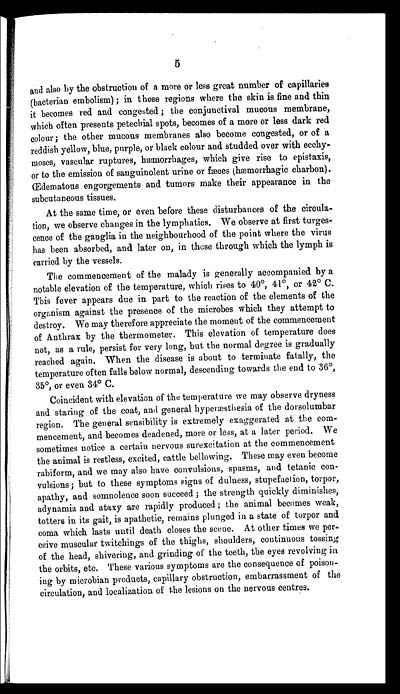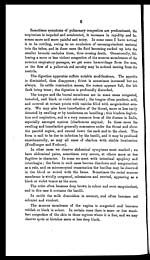Medicine - Veterinary > Civil Veterinary Departments > Civil Veterinary Department ledger series I-VI > Volume II - Anthrax
(105) Page 5
Download files
Individual page:
Thumbnail gallery: Grid view | List view

5
and also by the obstruction of a more or less great number of capillaries
(bacterian embolism); in those regions where the skin is fine and thin
it becomes red and congested; the conjunctival mucous membrane,
which often presents petechial spots, becomes of a more or less dark red
colour; the other mucous membranes also become congested, or of a
reddish yellow, blue, purple, or black colour and studded over with ecchy-
moses, vascular ruptures, hæmorrhages, which give rise to epistaxis,
or to the emission of sauguinolent urine or fæces (hæmorrhagic charbon).
(Edematous engorgements and tumors make their appearance in the
subcutaneous tissues.
At the same time, or even before these disturbances of the circula-
tion, we observe changes in the lymphatics. We observe at first turges-
cence of the ganglia in the neighbourhood of the point where the virus
has been absorbed, and later on, in these through which the lymph is
carried by the vessels.
The commencement of the malady is generally accompanied by a
notable elevation of the temperature, which rises to 40º, 41º, or 42º C.
This fever appears due in part to the reaction of the elements of the
organism against the presence of the microbes which they attempt to
destroy. We may therefore appreciate the moment of the commencement
of Anthrax by the thermometer. This elevation of temperature does
not, as a rule, persist for very long, but the normal degree is gradually
reached again. When the disease is about to terminate fatally, the
temperature often falls below normal, descending towards the end to 36º,
35°, or even 34° C.
Coincident with elevation of the temperature we may observe dryness
and staring of the coat, and general hyperæsthesia of the dorsolumbar
region. The general sensibility is extremely exaggerated at the com-
mencement, and becomes deadened, more or less, at a later period. We
sometimes notice a certain nervous surexcitation at the commencement
the animal is restless, excited, cattle bellowing. These may even become
rabiform, and we may also have convulsions, spasms, and tetanic con-
vulsions; but to these symptoms signs of dulness, stupefaction, torpor,
apathy, and somnolence soon succeed; the strength quickly diminishes,
adynamia and ataxy are rapidly produced; the animal becomes weak,
totters in its gait, is apathetic, remains plunged in a state of torpor and
coma which lasts until death closes the scene. At other times we per-
ceive muscular twitchings of the thighs, shoulders, continuous tossing
of the head, shivering, and grinding of the teeth, the eyes revolving in
the orbits, etc. These various symptoms are the consequence of poison-
ing by microbian products, capillary obstruction, embarrassment of the
circulation, and localization of the lesions on the nervous centres.
Set display mode to: Large image | Zoom image | Transcription
Images and transcriptions on this page, including medium image downloads, may be used under the Creative Commons Attribution 4.0 International Licence unless otherwise stated. ![]()
| India Papers > Medicine - Veterinary > Civil Veterinary Departments > Civil Veterinary Department ledger series I-VI > Anthrax > (105) Page 5 |
|---|
| Permanent URL | https://digital.nls.uk/75516086 |
|---|




